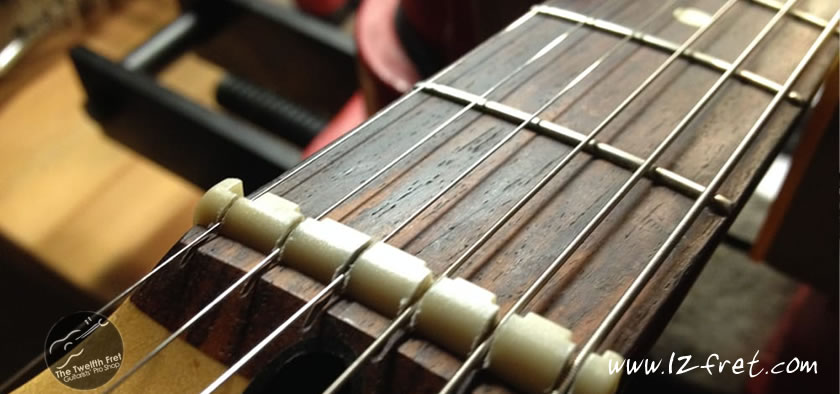
Intonation and Guitar Set Up
Most of the photos seen on The Twelfth Fret’s website are taken in a room next to the Repair Shop’s intake desk, usually the room I often spend time in. One of the most common requests I over hear is to replace tuning gears because the guitar won’t stay in tune. However, the parts are usually fine – the problem is that the guitar isn’t set up properly and can’t get in tune at all!
There are situations where parts do need adjustment and the tuning gears take the blame. A common problem is that the nut slots are too tight and the strings bind or catch. If you hear a “pinging” noise when using the tuning gear, and the pitch suddenly jumps – it’s the string catching in the nut. Rolling a pencil tip in the slot, or adding a small amount of light oil to the slot may help, but if not, the nut may require adjustment.
On electric guitars, pickup height can be a factor in tuning problems. You can raise pickups high enough to allow their magnets to interfere with the string’s vibration. To check this, press and play the outside strings at the highest frets. If you hear a wavering ‘wolf tone’, the pickups may be too close. Simply lower them until it goes away. Old or damaged strings can also vibrate inconsistently – simply change the strings to check this.
The word “intonation” refers to the accuracy of note pitches and is commonly used to refer to adjusting the saddle placement on a guitar bridge. Basically, the goal is to bring as many notes as possible ‘in tune’, but it’s never possible to get ALL notes in tune, except for the octave of a note – this will always be the precise multiple of the note’s lowest pitch.
The practical idea in setting intonation is to bring a given note and its octave into line. When set up properly, the pitch of a fretted note at, say, the 3rd fret will match the pitch on the 15th fret, one octave above.
While it’s possible to bring this pair of pitches into line, other notes will always be slightly off. All instruments use ‘tempering’ systems to allow twelve notes to fit pleasingly into an octave – perfect mathematical divisions don’t sound very good. Still, new tempering systems are introduced. The patented Buzz Feiten system describes adjusting the nut and saddle positions in a specific way, and then using pitch offsets of a few cents (hundredths of a semitone) on other notes. The Earvana nut has its own patents for compensating offsets, and doesn’t include the saddle or pitch tweaks.
On stringed instruments, fretted or bowed, all action adjustments affect how accurate pitches will be because they affect how much the string will stretch. As well, the player’s technique can dramatically alter pitches; guitars with higher frets require a lighter touch.
There are four basic elements to an instrument setup affecting intonation – the neck bow, the nut height, the string height, and the saddle location. The first three affect how much the string stretches when pressed against the fret or fingerboard and these are adjusted before the saddle location. For example, if the nut is too high, pressing a perfectly tuned open string at the first fret will send that note sharp. The Zero Fret, a fret that’s placed where the nut should be, was originally introduced to deal with this, and to provide a consistent feel along the neck.
The saddle location is set so that a pair of notes an octave apart match. The open string and the twelfth fret are often used as the reference standard, but using other fret pairs such as the 3rd and 15th or 5th and 17th may bring a better result.
The principle is simple – if the higher note is sharp relative to the lower note, the saddle is too close to the nut and must be moved further away. If it’s flat, it’s too far and must be moved closer.
On most electric instruments, it’s easy to adjust the saddles for proper intonation if you have an electronic tuner and the correct tool, and we’ll assume that the rest of the setup is correct. The better the tuner’s display, the easier this will be. Strobe tuners that display the harmonic elements of a note are ideal, but even clip-on tuners can be used if you’re careful and patient.
Bring all the open strings to pitch to the tuner. Play one open string and be sure that it’s correctly at pitch. Next, play note at the octave fret and observe the tuner. If the upper note is sharp or flat compared to the lower note, loosen the string a bit, and use the correct tool to move the saddle further from or closer to the nut. Tune the string back up to pitch and try again until the tuner shows those two pitches as in tune. Repeat for the other strings. Done!
~Patrick Keenan, The Twelfth Fret
